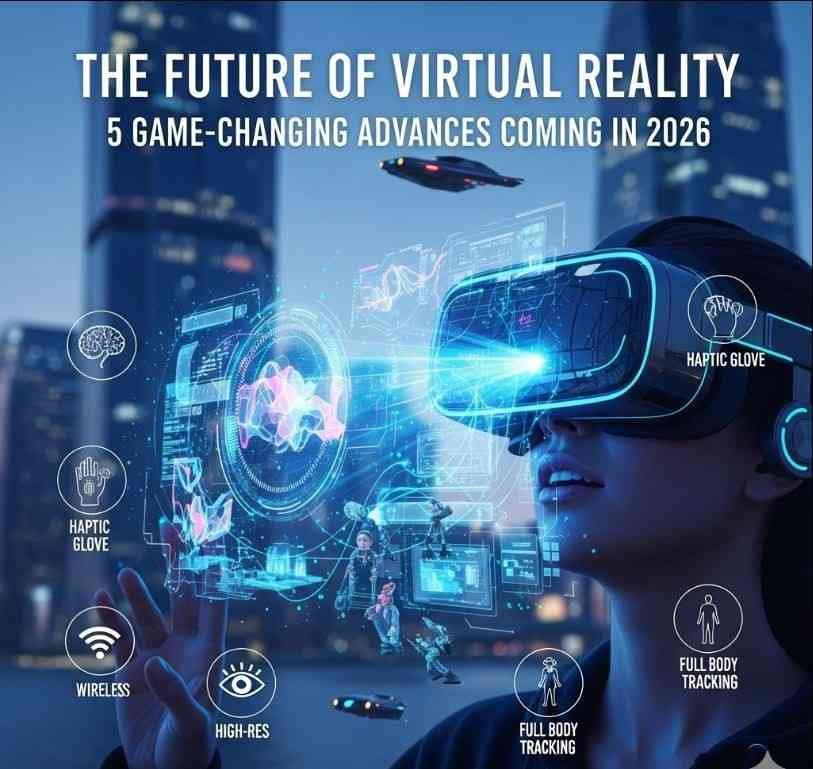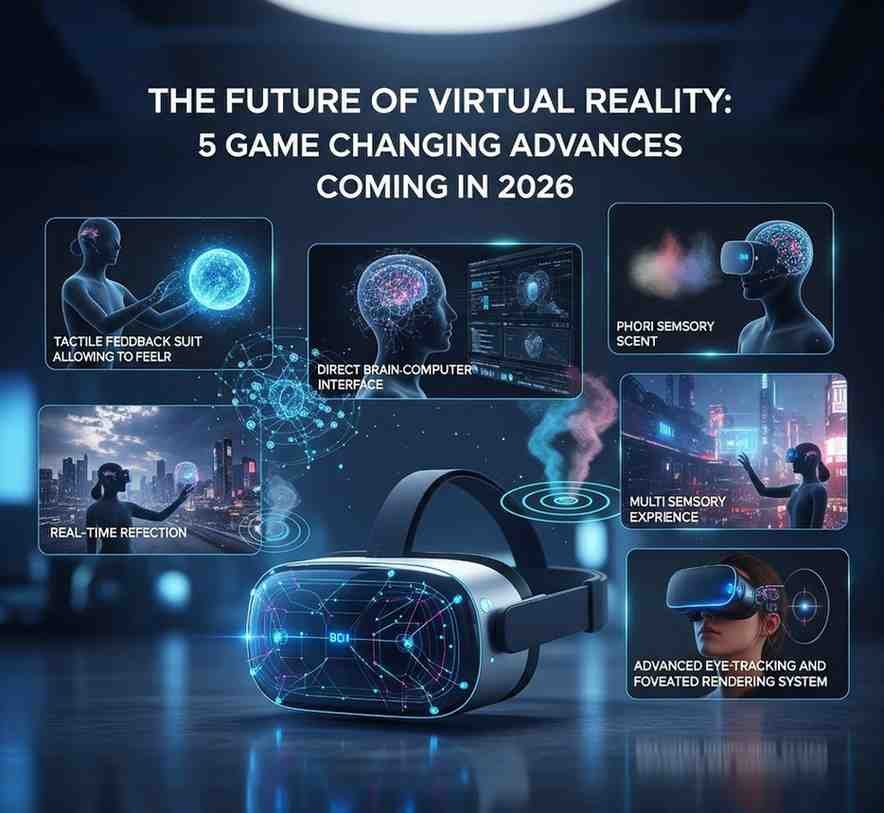
The Future of Virtual Reality: 5 Game-Changing Advances Coming in 2026
Virtual reality has come a long way since the bulky headsets and pixelated graphics of the early 2010s. As we stand at the threshold of 2025, the VR landscape is poised for another revolutionary leap forward. Industry experts and researchers are unanimous: 2026 will mark a pivotal year that transforms how we perceive and interact with virtual worlds.
Recent market analyses suggest VR adoption will reach 31 million users by the end of 2026, driven by breakthrough technologies that address current limitations. From ultra-lightweight headsets to haptic suits that let you feel virtual raindrops, the innovations brewing in labs worldwide promise to blur the line between digital and physical reality like never before.
This comprehensive exploration examines five groundbreaking VR advances expected to reshape the industry in 2026. These aren’t distant concepts—they’re tangible technologies currently in development phases, with prototypes already demonstrating remarkable capabilities. Whether you’re a tech enthusiast, industry professional, or simply curious about VR’s trajectory, understanding these developments will help you grasp the profound changes heading our way.
Breakthrough #1: Ultra-Lightweight Headsets That Feel Like Sunglasses
The weight barrier has long plagued VR adoption. Current mainstream headsets typically weigh between 500-800 grams, causing neck strain and limiting extended use. However, 2026 promises a dramatic shift toward ultra-lightweight designs that prioritize comfort without sacrificing performance.
Revolutionary Materials and Design
Leading manufacturers are experimenting with carbon fiber composites and advanced polymers that reduce headset weight by up to 70%. Meta’s research division has demonstrated prototypes weighing just 150 grams—comparable to a standard pair of sunglasses. These innovations stem from aerospace engineering principles, where every gram matters.
The secret lies in distributed weight architecture. Instead of concentrating components in a front-heavy design, engineers are spreading elements across the entire headset frame. Battery packs integrate into the rear strap, creating perfect weight balance that eliminates the “diving mask” sensation users often experience.
Enhanced Comfort Features
Beyond weight reduction, 2026 headsets incorporate adaptive padding systems that automatically adjust to individual facial structures. Memory foam gives way to programmable materials that remember your preferred fit and pressure distribution. Some prototypes even feature micro-climate control, maintaining optimal temperature around your eyes during extended sessions.
Prescription lens integration represents another significant advancement. Rather than clunky adapter inserts, new headsets accommodate vision correction through built-in adjustable optics, eliminating the need for glasses entirely during VR experiences.
Breakthrough #2: Haptic Technology That Makes Virtual Touch Feel Real

Touch remains VR’s most underdeveloped sense. While we can see and hear virtual environments convincingly, feeling them has proven challenging. 2026 brings haptic technology sophisticated enough to simulate textures, temperatures, and resistance with startling accuracy.
Full-Body Haptic Integration
Current haptic feedback typically limits itself to controller vibrations or basic hand sensations. The next generation expands this concept to full-body experiences through lightweight haptic suits and accessories. These garments contain thousands of micro-actuators that create localized sensations across your entire body.
Imagine feeling virtual wind during a flight simulation, experiencing the weight of armor in a medieval game, or sensing the texture of alien vegetation during space exploration. Advanced haptic systems translate digital interactions into physical sensations so convincing that users instinctively react to virtual objects as if they were real.
Ultrasonic Haptic Innovation
Perhaps most exciting is mid-air haptic technology that creates tactile sensations without physical contact. Ultrasonic arrays generate focused sound waves that produce pressure sensations on your skin, allowing you to feel virtual objects floating in space. This breakthrough eliminates the need for gloves or handheld devices while maintaining precise touch feedback.
Early demonstrations show users manipulating virtual interfaces with their bare hands while receiving tactile confirmation of button presses and texture variations. The technology works by creating acoustic radiation pressure at specific points in mid-air, essentially sculpting invisible physical sensations.
Breakthrough #3: Eye-Tracking Resolution That Matches Human Vision
Visual fidelity has consistently improved in VR, but 2026 introduces eye-tracking technology so precise it delivers perfect clarity exactly where you’re looking while maintaining efficiency elsewhere. This approach, called foveated rendering, revolutionizes both visual quality and computational efficiency.
Retina-Level Display Technology
Next-generation VR displays achieve pixel densities exceeding 4000 pixels per inch—surpassing human vision capabilities at typical viewing distances. Combined with advanced eye-tracking, these displays concentrate maximum resolution within your central vision area while reducing detail in peripheral regions where the human eye naturally sees less clearly.
This approach solves two critical problems simultaneously. Users experience crystal-clear imagery that eliminates the “screen door effect” entirely, while GPUs require significantly less processing power since they’re only rendering high-resolution graphics where eyes actually focus.
Dynamic Focus and Depth Perception
Variable focus technology addresses another long-standing VR limitation: the inability to focus on objects at different virtual distances. Current headsets force your eyes to focus at a fixed distance regardless of where objects appear in the virtual space, causing eye strain and breaking immersion.
2026 headsets incorporate varifocal displays that automatically adjust focus distance based on where you’re looking. When you shift attention from a nearby virtual object to a distant landscape, the display immediately adapts, creating natural depth perception identical to real-world vision.
Breakthrough #4: Wireless Technology That Eliminates All Latency Issues
Freedom from cables has been a VR goal since the technology’s inception. While wireless adapters exist, they often introduce latency, compression artifacts, or connection instability. 2026 brings wireless solutions that match or exceed wired connection quality through revolutionary transmission technologies.
WiGig 7 and Beyond
The latest wireless standards, including WiGig 7, offer bandwidth capabilities exceeding 100 Gbps—more than sufficient for uncompressed 8K per eye transmission at 120Hz refresh rates. These connections maintain sub-1ms latency, imperceptible to human senses and crucial for preventing motion sickness.
Advanced beamforming technology ensures stable connections even in challenging environments. Multiple antenna arrays create redundant signal paths, automatically switching to optimal frequencies when interference occurs. Users can move freely throughout large spaces without signal degradation or dropouts.
Intelligent Compression and Prediction
AI-powered compression algorithms analyze content in real-time, identifying which elements require full bandwidth and which can be efficiently compressed without perceptible quality loss. These systems learn from user behavior patterns, predicting where attention will focus and pre-loading high-quality assets accordingly.
Predictive rendering takes this concept further by anticipating head movements and pre-computing frames before they’re needed. Advanced motion sensors and AI algorithms work together to reduce perceived latency to negative values—frames arrive before users complete their movements.
Breakthrough #5: AI Integration That Creates Infinite Interactive Worlds
Perhaps the most transformative advancement coming in 2026 is AI integration sophisticated enough to generate unlimited, coherent virtual worlds in real-time. This technology moves beyond scripted experiences toward truly infinite, responsive environments that adapt to individual users.
Procedural World Generation
AI systems can now create vast, detailed worlds on-demand using advanced procedural generation techniques. These aren’t random landscapes but coherent environments with logical geography, consistent physics, and meaningful narratives. Users explore worlds that feel hand-crafted despite being generated moments before their arrival.
The technology extends beyond visual generation to include audio landscapes, weather systems, and even NPC behaviors. Virtual characters possess genuine personalities and memories, engaging in conversations that feel natural and unscripted. Each interaction influences how these characters behave in future encounters, creating truly dynamic relationships.
Personalized Experience Adaptation
Machine learning algorithms continuously analyze user preferences and behaviors, tailoring experiences to individual interests and skill levels. A virtual historical recreation might emphasize political intrigue for one user while focusing on architectural details for another, all generated dynamically based on engagement patterns.
This personalization extends to accessibility features as well. AI systems automatically adjust interface elements, movement mechanics, and sensory feedback based on individual needs and capabilities, making VR experiences truly inclusive for users with varying physical abilities.
The Convergence Effect: When Technologies Unite
The real magic happens when these breakthrough technologies work together. Lightweight headsets with perfect visual clarity, combined with full-body haptic feedback and AI-generated worlds, create experiences that transcend current VR limitations entirely.
Consider a virtual concert where you feel the bass vibrations through your haptic suit while AI generates unique performances based on audience energy. Or imagine architectural visualization where you can touch and manipulate building materials with realistic haptic feedback while the AI suggests design modifications in real-time.
These convergent experiences represent a fundamental shift from VR as entertainment toward VR as an alternative reality platform. Professional training, social interaction, creative collaboration, and educational exploration all benefit from this technological synthesis.
Industry Impact and Market Predictions
Market analysts predict the combined effect of these technologies will drive VR adoption beyond the current enthusiast market into mainstream acceptance. When headsets become as comfortable as sunglasses, offer perfect visual clarity, provide realistic touch feedback, and generate infinite content, barriers to entry largely disappear.
Enterprise applications particularly benefit from these advances. Medical training with realistic haptic feedback, architectural collaboration in infinite virtual spaces, and remote work environments that feel genuinely present become practical realities rather than experimental concepts.
Education stands to gain tremendously as well. Students can explore ancient Rome with historical accuracy, manipulate molecular structures with their hands, or walk through mathematical concepts made tangible. The combination of AI-generated content and realistic sensory feedback creates learning experiences impossible in traditional classrooms.
Preparing for the VR Revolution of 2026
Understanding these incoming changes helps individuals and organizations prepare for VR’s next evolutionary phase. For tech enthusiasts, 2026 represents an opportunity to experience computing in entirely new ways. For businesses, these advances open doors to applications previously constrained by technical limitations.
The infrastructure requirements are evolving as well. High-bandwidth internet becomes increasingly crucial for cloud-based AI content generation. Computing power shifts from local devices to distributed processing, changing how we think about VR hardware ownership and upgrade cycles.
Content creators face both opportunities and challenges. The potential for infinite AI-generated worlds democratizes content creation while requiring new skills in AI collaboration and procedural design principles. Traditional game development paradigms must evolve to leverage these revolutionary capabilities.
What This Means for Your VR Journey
As we approach 2026, the virtual reality landscape transforms from a niche technology to a fundamental computing platform. The convergence of lightweight hardware, advanced haptics, perfect vision, seamless connectivity, and intelligent AI creates possibilities we’re only beginning to imagine.
Whether you’re planning your first VR purchase, considering enterprise implementation, or simply curious about technology’s trajectory, 2026 represents a pivotal moment. The advances detailed here aren’t speculative futures—they’re active developments with working prototypes and committed release timelines.
The question isn’t whether these technologies will arrive, but how quickly we’ll adapt to a world where virtual and physical reality blend seamlessly. Start exploring VR today to understand its current capabilities, because tomorrow’s advances will build upon the foundation being laid right now.
The future of virtual reality is arriving faster than most realize, and 2026 will be remembered as the year VR truly came of age.
Read more articles here
- How to Download Your Telangana Family Member Certificate Soft Copy (FMC)
- Top 5 Indian Cities to Buy Property in 2025: Investment & Growth Guide
- 100+ Unique Anniversary Wishes for Everyone You Know
- Top 15 Best Indian Social Media & AI Apps (2025): Revolutionizing Bharat’s Digital Future
- 1000+ Happy Birthday Wishes for Everyone in Your Life









